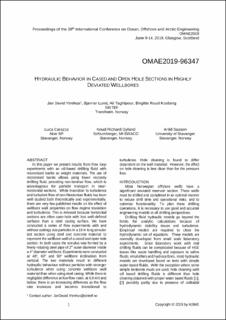| dc.contributor.author | Ytrehus, Jan David | |
| dc.contributor.author | Lund, Bjørnar | |
| dc.contributor.author | Taghipour, Ali | |
| dc.contributor.author | Kosberg, Birgitte Ruud | |
| dc.contributor.author | Carazza, Luca | |
| dc.contributor.author | Gyland, Knud Richard | |
| dc.contributor.author | Saasen, Arild | |
| dc.date.accessioned | 2023-01-19T15:57:38Z | |
| dc.date.available | 2023-01-19T15:57:38Z | |
| dc.date.created | 2019-12-27T12:43:51Z | |
| dc.date.issued | 2019 | |
| dc.identifier.citation | Ytrehus, J. D., Lund, B., Taghipour, A., Kosberg, B. R., Carazza, L., Gyland, K. R., & Saasen, A. (2021). Hydraulic Behavior in Cased and Open-Hole Sections in Highly Deviated Wellbores. Journal of Energy Resources Technology, 143(3). | en_US |
| dc.identifier.isbn | 978-0-7918-5887-5 | |
| dc.identifier.uri | https://hdl.handle.net/11250/3044735 | |
| dc.description.abstract | In this paper we present results from flow loop experiments with an oil-based drilling fluid with micronized barite as weight materials. The use of micronized barite allows using lower viscosity drilling fluid, providing non-laminar flow, which is advantageous for particle transport in near-horizontal sections. While transition to turbulence and turbulent flow of non-Newtonian fluids has been well studied both theoretically and experimentally, there are very few published results on the effect of wellbore wall properties on flow regime transition and turbulence. This is relevant because horizontal sections are often open-hole with less well-defined surfaces than a steel casing surface. We have conducted a series of flow experiments with and without cuttings size particles in a 10 m long annular test section using steel and concrete material to represent the wellbore wall of a cased and open hole section. In both cases the annulus was formed by a freely rotating steel pipe of 2” outer diameter inside a 4” diameter wellbore. Experiments were conducted at 48°, 60° and 90° wellbore inclination from vertical. The two materials result in different hydraulic behaviour without particles with stronger turbulence when using concrete wellbore wall material than when using steel casing. While there is negligible difference at low flow rates, at 0.8 m/s and below, there is an increasing difference as the flow rate increases and becomes transitional to turbulence. Hole cleaning is found to differ dependent on the wall material. However, the effect on hole cleaning is less clear than for the pressure loss. | en_US |
| dc.language.iso | eng | en_US |
| dc.publisher | ASME | en_US |
| dc.relation.ispartof | ASME 2019 38th International Conference on Ocean, Offshore and Arctic Engineering (OMAE2019): Volume 8: Polar and Arctic Sciences and Technology; Petroleum Technology | |
| dc.title | Hydraulic Behavior in Cased and Open Hole Sections in Highly Deviated Wellbores | en_US |
| dc.type | Chapter | en_US |
| dc.description.version | acceptedVersion | en_US |
| dc.rights.holder | The authors | en_US |
| dc.subject.nsi | VDP::Teknologi: 500 | en_US |
| dc.identifier.doi | 10.1115/OMAE2019-96347 | |
| dc.identifier.cristin | 1763954 | |
| cristin.unitcode | 217,8,6,0 | |
| cristin.unitname | Institutt for energi- og petroleumsteknologi | |
| cristin.ispublished | true | |
| cristin.fulltext | postprint | |
| cristin.qualitycode | 1 | |
